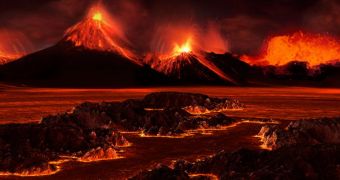The Permian–Triassic (P-T) extinction event is without a doubt the most massive and significant mass death ever to occur on Earth. Scientists estimate that it took place 252.2 million years ago, arguing that it wiped out 70 percent of all life on land, and 96 percent of all marine species. A new study indicates that the P-T event occurred nearly instantaneously.
Scientists at the Massachusetts Institute of Technology (MIT) in Cambridge say that the extinction occurred over a period as short as 60,000 years, give or take 48,000 years. The P-T event may have therefore lasted either 12,000, or 108,000 years. Either way, this is the blink of an eye in geological time.
Previously, scientists believed that the mass dying occurred over more extended periods of time, ranging from a few tens of thousands to a few million years. However, the new study used more precise dating techniques than ever before to show that this was not actually the case.
The reason why determining the time scale of the P-T extinction is so important is that this value may help researchers decide on which theory best fits what happened. There are currently numerous ideas about what went wrong 252 million years ago, but choosing one explanation over any another has proven difficult.
“We’ve got the extinction nailed in absolute time and duration. How do you kill 96 percent of everything that lived in the oceans in tens of thousands of years? It could be that an exceptional extinction requires an exceptional explanation,” says the MIT Robert R. Shrock professor of Earth and planetary sciences, Sam Bowring.
Some of the explanations for the P-T event proposed to date include a series of massive eruptions from supervolcanoes, a devastating asteroid impact, or even an out-of-control cascade of climate abnormalities – such as a global ecosystem collapse.
MIT graduate student Seth Burgess also found that the world's oceans experienced a period of severe acidification around 10,000 years before the extinction event, suggesting that massive volumes of carbon dioxide were pumped into the atmosphere. This may have increased sea temperatures to a point where most marine life died off.
“It is clear that whatever triggered extinction must have acted very quickly, fast enough to destabilize the biosphere before the majority of plant and animal life had time to adapt in an effort to survive,” says Burgess, who was the lead author of the new study.
Details of the work were published in this week's issue of the esteemed journal Proceedings of the National Academy of Sciences (PNAS).

 14 DAY TRIAL //
14 DAY TRIAL //